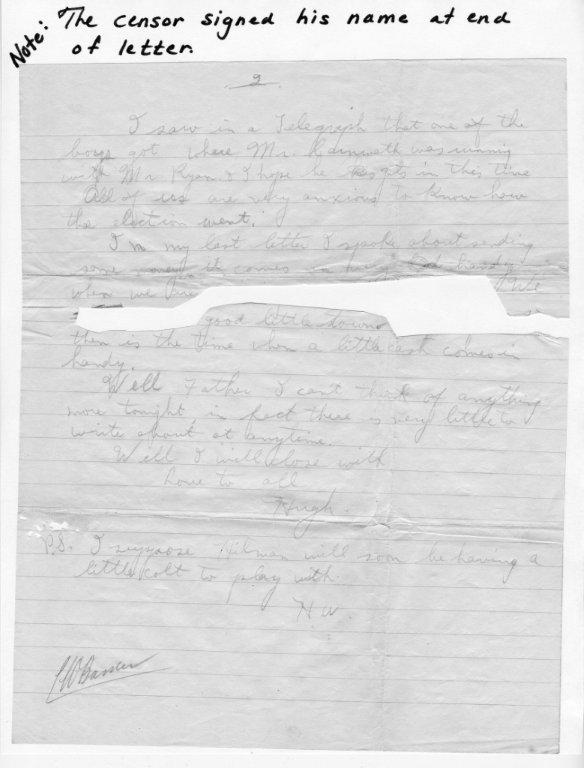This World War I letter was written by Hugh C. Wright of Shepody (Hopewell) Albert County on March 11, 1917 while he was in serving in the Canadian Garrison Artillery in France. Hugh had enlisted in the 26th Battalion on November 17, 1914 when he was 19 years old. He sailed with the 26th Bn from Saint John on June 13, 1915 aboard the steamship “Caledonia”. They arrived in England on June 24, 1915 where they underwent rigorous training in preparation for going to the battle front.
Hugh served in the 26th Bn, 5th Infantry Brigade in Belgium and France spending 17 months in the trenches. In February 1917, he transferred to the 4th Siege Battery, 2nd Brigade CGA and was a gunner for the remainder of the war. He was discharged on May 10, 1919...on his 24th birthday!
Hugh Wright was the youngest son of James and Jane Wright. Hugh's letters are addressed … “Dear Father” because his mother had died when he was only 7 years old.
The letter was written in pencil and the censor had cut out words that might give information of location if intercepted by the enemy. The censor also signed his name at the bottom of the last page of the letter.
“I am very fortunate to have over 50 letters that my Great Uncle Hugh wrote to his family while serving in WWI”. Great Niece Dawne McLean
With many thanks to Hugh Wright's great niece, Dawne McLean who kindly submitted the letter.
"
March 11, 1917 France
Dear Father,
I am writing tonight sitting outdoors and believe me it is one fine night, nice and warm and is really the first warm day we have had this spring so far.
It has been some time since I wrote but we are (words cut out by censor) that a person does not get much chance to write, so I hope you don't worry much about me.
I like the Battery fine. I have had more time to myself since I came here that I had all the time I was in (words cut out by censor). Of course we are not idle all the time, we certainly have some hard work at times.
I have not seen Clarke since I came here as he is a rear guard someplace, but I guess he is having a fairly easy time, but I imagine he would sooner be back with the boys.
I have only got one parcel since I came here and that was from Mrs. Paul Robinson. The last letter that I had from home was the one with the clipping of Mr. McClelan in it.
I had a long letter from Uncle Silas yesterday and he said that he was sending me a box so I hope that it soon gets here.
I saw in a Telegraph that one of the boys got where Mr. Carnwarth was running with Mr. Ryan and I hope he gets in this time. All of us are very anxious to know how the election went.
In my last letter I spoke about sending some money, it comes in very handy when we are (words cut out by censor) good little town (words cut out by censor) then is the time when a little cash comes in handy.
Well, Father I can't think of anything more tonight, in fact there is very little to write about anytime.
Well, I will close with
Love to all
Hugh
P.S. I suppose Hillman will soon be having a little colt to play with.
HW
(And the letter is signed at the bottom by the censor LW Bassler )

